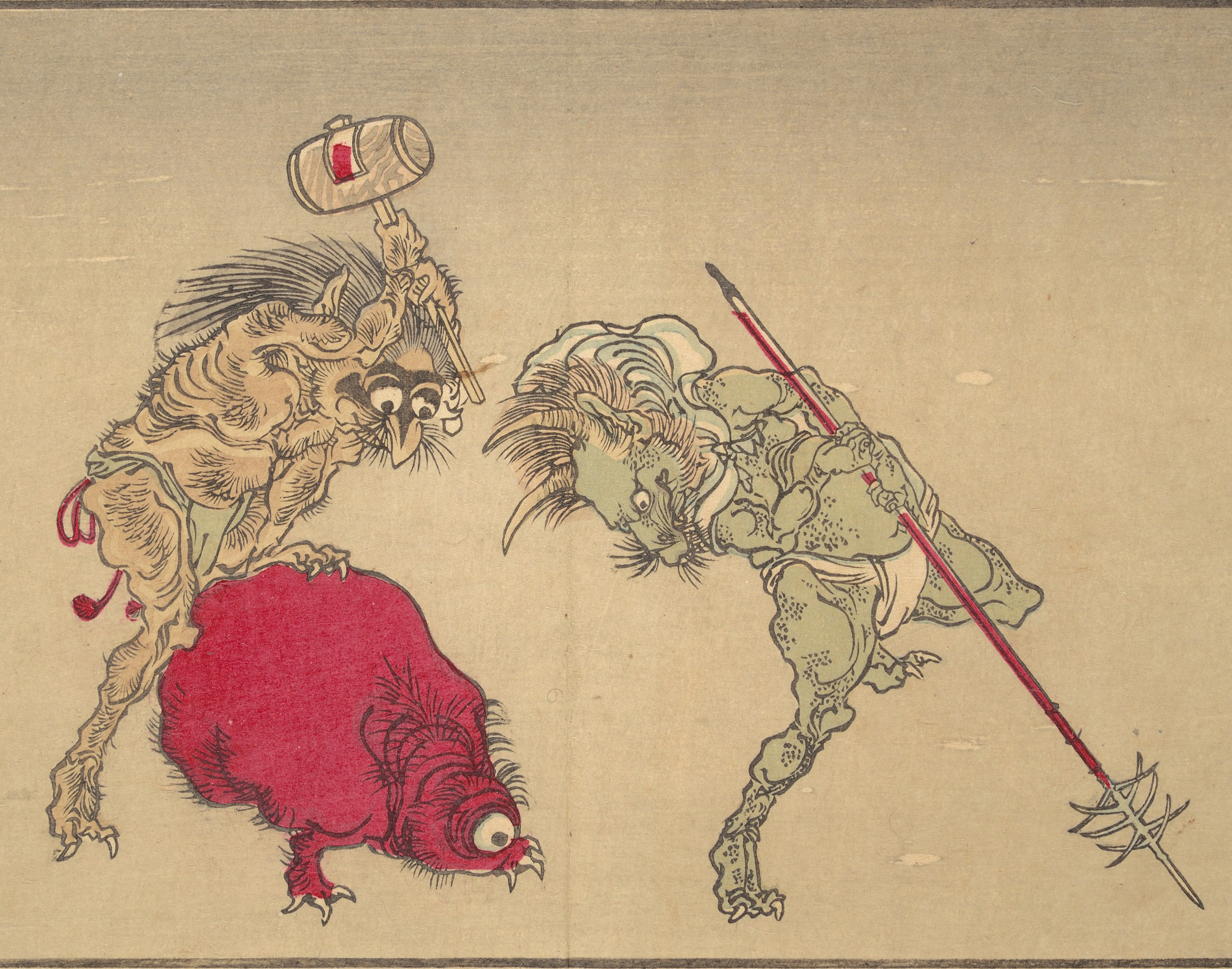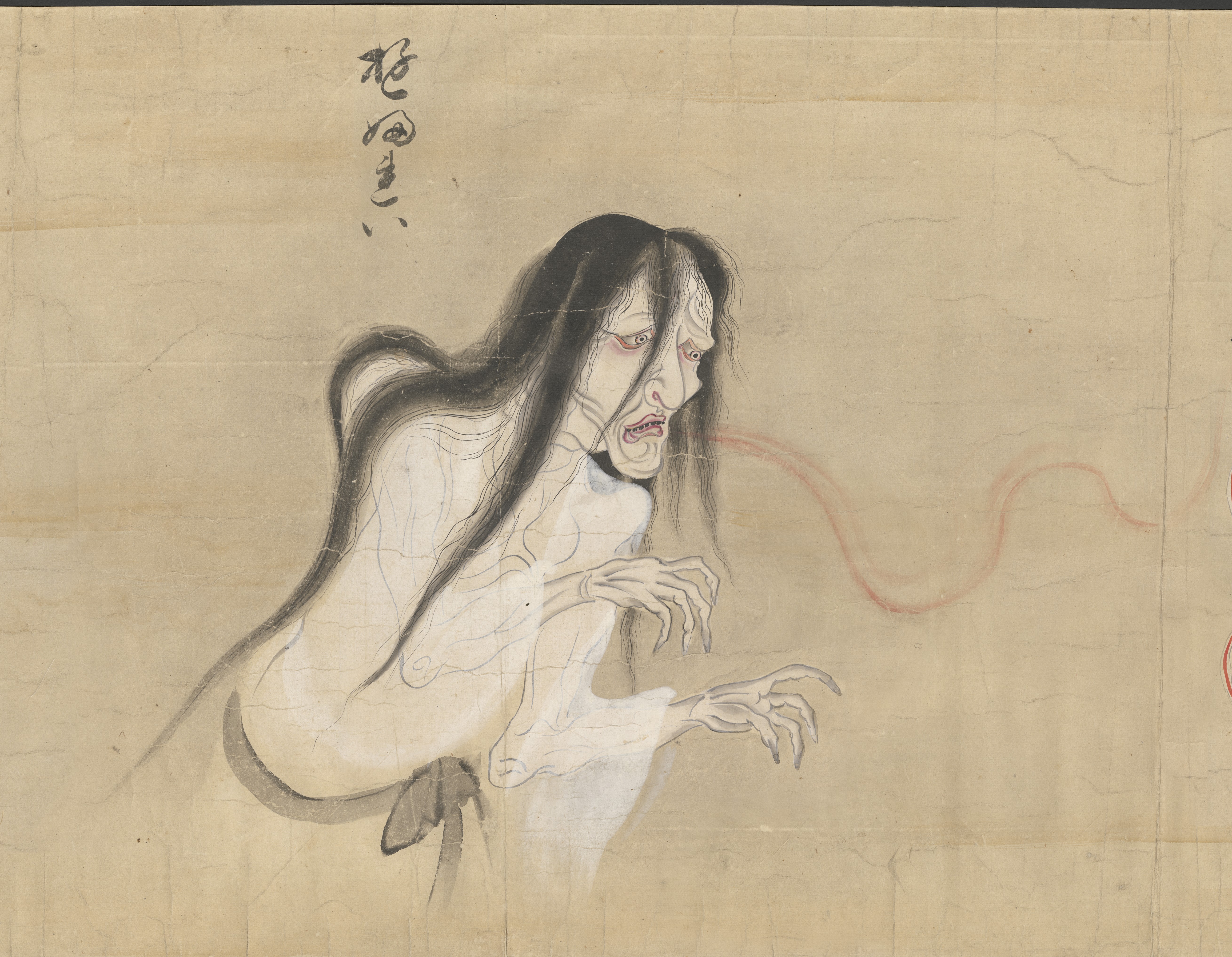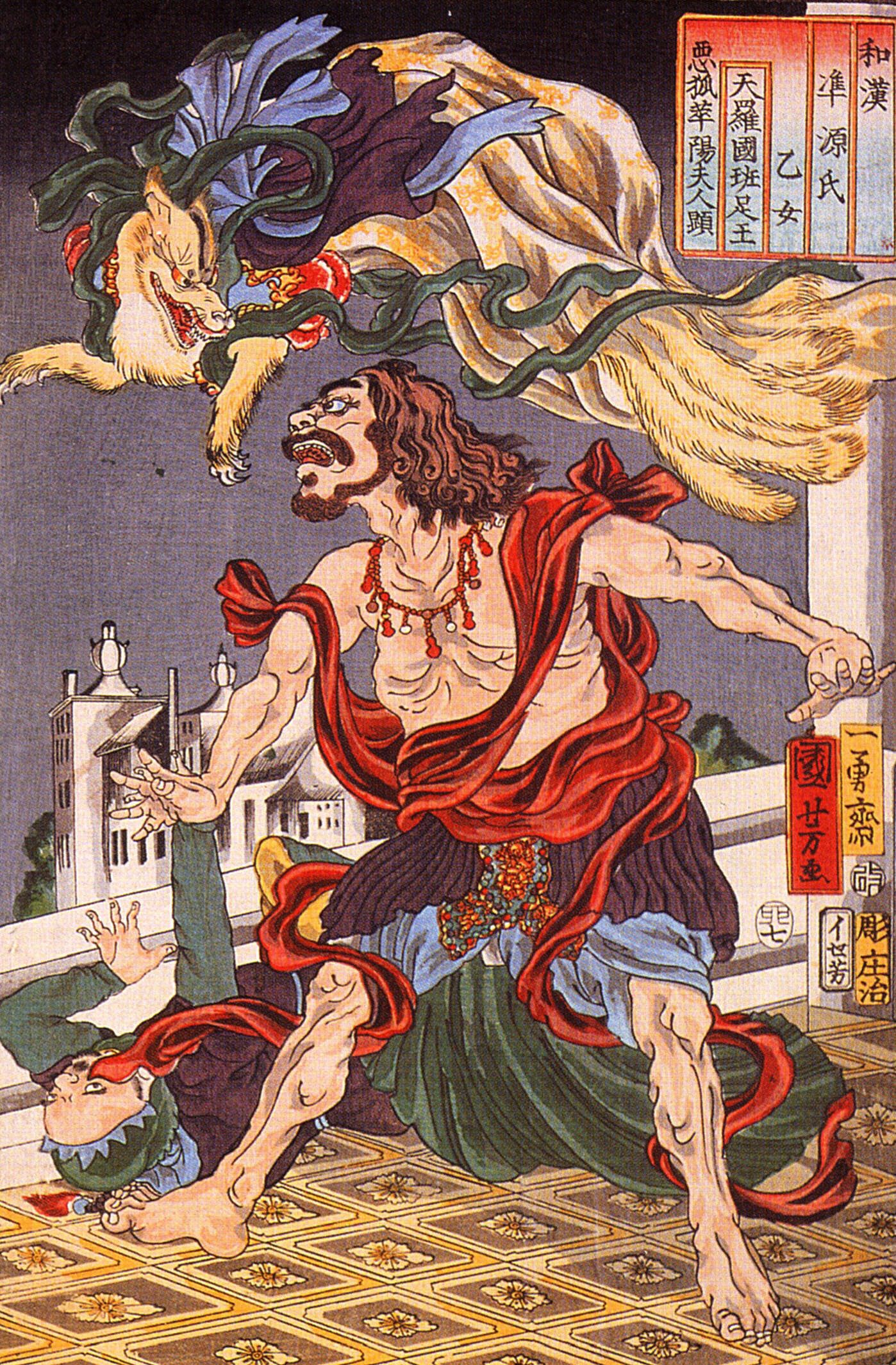|
Obake
and are a class of ''yōkai'', preternatural creatures in Japanese folklore. Literally, the terms mean ''a thing that changes'', referring to a state of transformation or shapeshifting. These words are often translated as "ghost", but primarily they refer to living things or supernatural beings who have taken on a temporary transformation, and these ''bakemono'' are distinct from the spirits of the dead. However, as a secondary usage, the term ''obake'' can be a synonym for '' yūrei'', the ghost of a deceased human being. A ''bakemono's'' true form may be an animal such as a fox (''kitsune''), a raccoon dog ('' bake-danuki''), a badger ('' mujina''), a transforming cat ('' bakeneko''), the spirit of a plant—such as a '' kodama'', or an inanimate object which may possess a soul in Shinto and other animistic traditions. ''Obake'' derived from household objects are often called ''tsukumogami''. A ''bakemono'' usually either disguises itself as a human or appears in a stra ... [...More Info...] [...Related Items...] OR: [Wikipedia] [Google] [Baidu] |
Yōkai
are a class of supernatural entities and spirits in Japanese folklore. The word is composed of the kanji for "attractive; calamity" and "apparition; mystery; suspicious." are also referred to as , or . Despite often being translated as such, are not literally demons in the Western sense of the word, but are instead spirits and entities. Their behavior can range from malevolent or mischievous to benevolent to humans. often have animal features (such as the , depicted as appearing similar to a turtle, and the , commonly depicted with wings), but may also appear humanoid in appearance, such as the . Some resemble inanimate objects (such as the ), while others have no discernible shape. are typically described as having spiritual or supernatural abilities, with shapeshifting being the most common trait associated with them. that shapeshift are known as or . Japanese folklorists and historians explain as personifications of "supernatural or unaccountable phenomena ... [...More Info...] [...Related Items...] OR: [Wikipedia] [Google] [Baidu] |
Tsukumogami
In Japanese folklore, ''tsukumogami'' (付喪神 or つくも神, lit. "tool ''kami''") are tools that have acquired a kami or spirit. According to an annotated version of '' The Tales of Ise'' titled ''Ise Monogatari Shō'', there is a theory originally from the ''Onmyōki'' (陰陽記) that foxes and tanuki, among other beings, that have lived for at least a hundred years and changed forms are considered ''tsukumogami''. In modern times, the term can also be written 九十九神 (literally ninety-nine ''kami''), to emphasize the agedness. According to Komatsu Kazuhiko, the idea of a ''tsukumogami'' or a ''yōkai'' of tools spread mostly in the Japanese Middle Ages and declined in more recent generations. Komatsu infers that despite the depictions in Bakumatsu period ukiyo-e art leading to a resurfacing of the idea, these were all produced in an era cut off from any actual belief in the idea of ''tsukumogami''. Because the term has been applied to several different concepts i ... [...More Info...] [...Related Items...] OR: [Wikipedia] [Google] [Baidu] |
Bakeneko
The (, "changed cat") is a type of Japanese , or supernatural entity; more specifically, it is a , or supernatural cat. It is often confused with the , another cat-like . The distinction between them is often ambiguous, but the largest difference is that the has two tails, while the has only one. There are legends of in various parts of Japan, but the tale of the Nabeshima Disturbance in Saga Prefecture is especially famous. Origin The reason that cats are seen as in Japanese mythology is attributed to many of their characteristics: for example, the irises of their eyes change shape depending on the time of day, their fur can seem to cause sparks when they are petted (due to static electricity), they sometimes lick blood, they can walk without making a sound, their wild nature that remains despite the gentleness they can show, they are difficult to control (unlike dogs), their sharp claws and teeth, nocturnal habits, and their speed and agility.1994、125–127。2005、156� ... [...More Info...] [...Related Items...] OR: [Wikipedia] [Google] [Baidu] |
Yūrei
are figures in Japanese folklore analogous to the Western model of ghosts. The name consists of two kanji, (''yū''), meaning "faint" or "dim" and (''rei''), meaning "soul" or "spirit". Alternative names include , meaning ruined or departed spirit, , meaning dead spirit, or the more encompassing or . Like their Chinese, Korean, and Western counterparts, they are thought to be spirits barred from a peaceful afterlife. Japanese afterlife According to traditional Japanese beliefs, all humans have a spirit or soul called a . When a person dies, the ''reikon'' leaves the body and enters a form of purgatory, where it waits for the proper funeral and post-funeral rites to be performed so that it may join its ancestors. If this is done correctly, the ''reikon'' is believed to be a protector of the living family and to return yearly in August during the Obon Festival to receive thanks. If the person dies, however, in a sudden or violent manner such as murder or suicide, if the pr ... [...More Info...] [...Related Items...] OR: [Wikipedia] [Google] [Baidu] |
Glen Grant (historian)
Glen Grant (February 23, 1947 – June 19, 2003) was a Hawaiian historian, author and folklorist. He was primarily known for his Obake Files, a collection of articles and stories regarding native and imported folktales and mythology in Hawaii. Grant was also the author of the Chicken Skin series of ghost story anthologies, as well as host of the long-running radio show of the same name. Life Grant was born and raised in the west Los Angeles area near Palms and Culver City. He was the son of Hollywood special effects wizard Cliff Grant, who worked on such films as '' Gone with the Wind'', ''The Wizard of Oz'' and ''Forbidden Planet.'' The elder Grant helped create the extraterrestrial robot Gort from '' The Day the Earth Stood Still'' and Robby the Robot from ''Forbidden Planet''. "Robby eventually became a member of the Grant household, where the younger Grant said he would see the robot, stashed in the family garage, on a daily basis. Though the robot ultimately ended up in a ... [...More Info...] [...Related Items...] OR: [Wikipedia] [Google] [Baidu] |
Hitotsume-kozō
''Hitotsume-kozō'' (一つ目小僧) are a '' Yōkai'' (supernatural apparition) of Japan that take on the appearance of a bald-headed child with one eye in the center of its forehead similar to a cyclops. Summary They generally do not cause any injury, are said to suddenly appear and surprise people, and are a comparatively harmless type of yōkai. By that, it can be said that their behavior could also be understood in terms of the '' karakasa-obake''. Perhaps because they don't perform bad deeds, when they are depicted in pictures, they are often depicted cutely, or in a humorous design. In '' yōkai karuta'', ''hitotsume-kozō'' are depicted carrying ''tōfu'', but according to the ''yōkai'' researcher Katsumi Tada, since "" leads to "", hitotsume-kozō are supposed to dislike beans, but somehow before anyone knew it the ''hitotsume-kozō'' switched to having ''tōfu'' (made from soybeans) as its favorite food. Additionally, this said to be related to the ''tōfu-kozō''. ... [...More Info...] [...Related Items...] OR: [Wikipedia] [Google] [Baidu] |
Noppera-bō
The , or faceless ghost, is a Japanese yōkai that looks like a human but has no face. They are sometimes mistakenly referred to as a '' mujina'', an old Japanese word for a badger or raccoon dog. Although the ''mujina'' can assume the form of the other, ''noppera-bō'' are usually disguised as humans. Such creatures were thought to sometimes transform themselves into ''noppera-bō'' in order to frighten humans. Lafcadio Hearn used the animals' name as the title of his story about faceless monsters, probably resulting in the misused terminology. ''Noppera-bō'' are known primarily for frightening humans, but are usually otherwise harmless. They appear at first as ordinary human beings, sometimes impersonating someone familiar to the victim, before causing their features to disappear, leaving a blank, smooth sheet of skin where their face should be. In legends Often, a ''noppera-bō'' would not actually exist, but was the disguise of a '' mujina'', a fox ''kitsune'', or a '' tanuk ... [...More Info...] [...Related Items...] OR: [Wikipedia] [Google] [Baidu] |
Shapeshifting
In mythology, folklore and speculative fiction, shape-shifting is the ability to physically transform oneself through an inherently superhuman ability, divine intervention, demonic manipulation, sorcery, spells or having inherited the ability. The idea of shape-shifting is in the oldest forms of totemism and shamanism, as well as the oldest existent literature and epic poems such as the ''Epic of Gilgamesh'' and the ''Iliad''. The concept remains a common literary device in modern fantasy, children's literature and popular culture. Folklore and mythology Popular shape-shifting creatures in folklore are werewolves and vampires (mostly of European, Canadian, and Native American/early American origin), ichchadhari naag and ichchadhari naagin (shape-shifting cobras) of India, the huli jing of East Asia (including the Japanese ''kitsune'' and Korean ''kumiho''), and the gods, goddesses, and demons and demonesses like succubus and incubus and other numerous mythologies, s ... [...More Info...] [...Related Items...] OR: [Wikipedia] [Google] [Baidu] |
Shinto
Shinto () is a religion from Japan. Classified as an East Asian religion by scholars of religion, its practitioners often regard it as Japan's indigenous religion and as a nature religion. Scholars sometimes call its practitioners ''Shintoists'', although adherents rarely use that term themselves. There is no central authority in control of Shinto, with much diversity of belief and practice evident among practitioners. A polytheistic and animistic religion, Shinto revolves around supernatural entities called the . The are believed to inhabit all things, including forces of nature and prominent landscape locations. The are worshiped at household shrines, family shrines, and ''jinja'' public shrines. The latter are staffed by priests, known as , who oversee offerings of food and drink to the specific enshrined at that location. This is done to cultivate harmony between humans and and to solicit the latter's blessing. Other common rituals include the dances, rites of pa ... [...More Info...] [...Related Items...] OR: [Wikipedia] [Google] [Baidu] |
Shapeshifting
In mythology, folklore and speculative fiction, shape-shifting is the ability to physically transform oneself through an inherently superhuman ability, divine intervention, demonic manipulation, sorcery, spells or having inherited the ability. The idea of shape-shifting is in the oldest forms of totemism and shamanism, as well as the oldest existent literature and epic poems such as the ''Epic of Gilgamesh'' and the ''Iliad''. The concept remains a common literary device in modern fantasy, children's literature and popular culture. Folklore and mythology Popular shape-shifting creatures in folklore are werewolves and vampires (mostly of European, Canadian, and Native American/early American origin), ichchadhari naag and ichchadhari naagin (shape-shifting cobras) of India, the huli jing of East Asia (including the Japanese ''kitsune'' and Korean ''kumiho''), and the gods, goddesses, and demons and demonesses like succubus and incubus and other numerous mythologies, s ... [...More Info...] [...Related Items...] OR: [Wikipedia] [Google] [Baidu] |
Kitsune
In Japanese folklore, , are foxes that possess paranormal abilities that increase as they get older and wiser. According to ''yōkai'' folklore, all foxes have the ability to shapeshift into human form. While some folktales speak of employing this ability to trick others—as foxes in folklore often do—other stories portray them as faithful guardians, friends, and lovers. Foxes and humans lived close together in ancient Japan; this companionship gave rise to legends about the creatures. have become closely associated with Inari, a Shinto or spirit, and serve as its messengers. This role has reinforced the fox's supernatural significance. The more tails a has—they may have as many as nine—the older, wiser, and more powerful it is. Because of their potential power and influence, some people make sacrifices to them as to a deity. Conversely foxes were often seen as " witch animals", especially during the Edo period (1603–1867), and were thought of as goblins who could ... [...More Info...] [...Related Items...] OR: [Wikipedia] [Google] [Baidu] |








